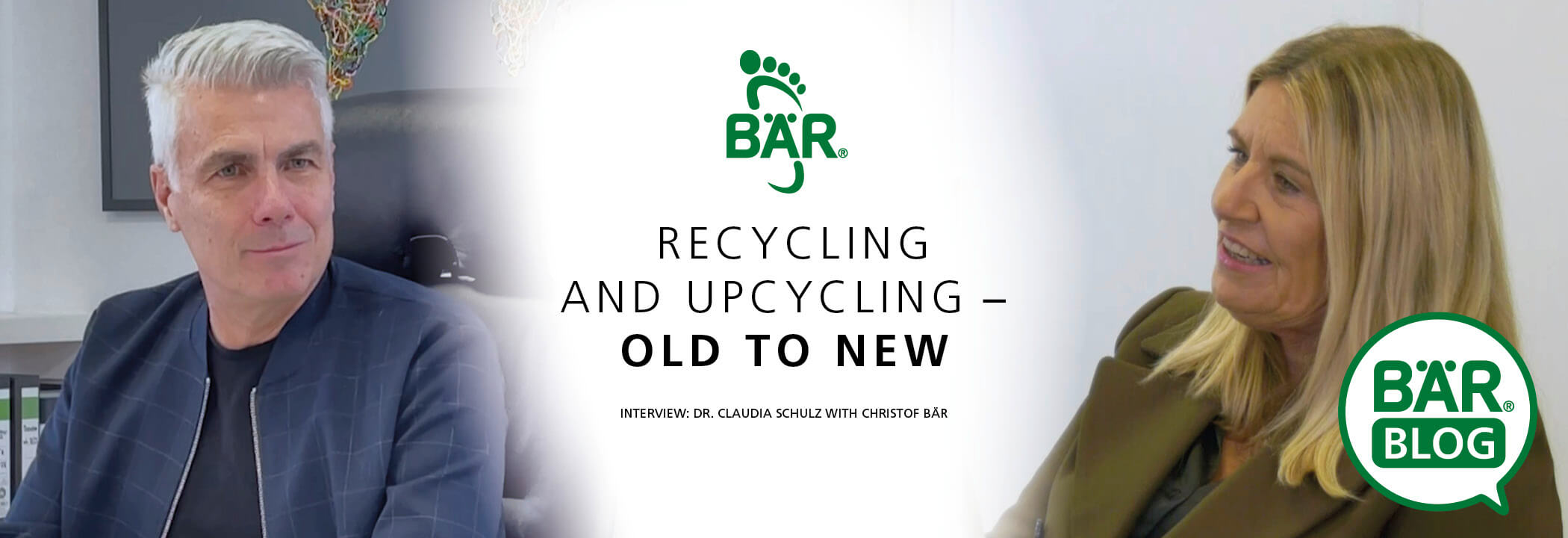Interview: Recycling and upcycling - old to new

Watch the interview live on YouTube or read the full story here. Find out how BÄR uses recycling and upcycling to turn old into new!
INTERVIEW BETWEEN DR. CLAUDIA SCHULZ AND CHRISTOF BÄR:
Dr. Claudia Schulz: In this context, I must of course also ask: what about recycling and upcycling? These are two very important aspects in the shoe world. Are there materials that you recycle or buy recycled or that are even upcycled?
Christof Bär: Yes, for some time now we have also been working with yarns made from recycled plastics / plastic from the sea in the knitted shoe / textile shoe sector. This yarn is called SEAQUAL and we also support a project by the Bio Design Foundation, which collects waste from the oceans with its VOX MARIS project. They are now very committed. It's great what they've done in terms of developments, we've been supporting them for a while and they're passionate about it and are growing by showing that what they're doing works. Of course, this prompted us to say: Yes, we are happy to use these yarns and we also support the movement that says I am freeing the oceans and we are doing this on a voluntary basis. Our support consists of thinking about how we can develop something together with you that can be reintroduced into the cycle in a recycling process.
Dr. Claudia Schulz: That would have been my next question. A textile shoe may not last as long as a leather shoe. Does that mean I can recycle it again, the classic example of the circular economy, and make a new shoe out of it?
Christof Bär: Yes, that works. You have to admit, it's not the easiest task with shoes, because you're working with an incredible number of different materials, so a parts list can consist of up to 50 different materials. A T-shirt is easier and cars are now labeled so that you can take them apart again. It's a bit more difficult with shoes, which is why we don't do it ourselves, but once a year we always have an "old for new" campaign where we ask customers to "return your old shoes to us, even to the store, and you'll get a voucher for something new in return". So if the shoes are really worn out, you don't just put them in the residual waste for incineration, but you say, "I'll give them back," and we bundle them up and hand them over to service providers. On the one hand, we naturally check what can be used to donate to people in need, in the sense that the shoes are reused. We work together with institutions that distribute our shoes to Ukraine or other facilities for use. What we then see is no longer applicable for this process. We then hand it over to the service provider, who in turn says, "What can I really still use from this to reintroduce it into the process? In the end, there is only a small amount left over, but it is unavoidable and can no longer be used. But to really drive this curve down and say: the greatest possible reuse of the product, that's what we're pushing for.
Dr. Claudia Schulz: And has this always been the case at BÄR or have you recently become even more involved in these issues?
Christof Bär: In principle, that has grown. We used to look at it from a completely different perspective, from the natural family business, where you simply don't throw anything away. You think about what else you can do with it. And that's how the idea became established. A lot of things have to be viewed critically today. I'm thinking of whitewashing or greenwashing, which is something where I say there is a lot of advertising and money being spent, and as a Swabian company we are perhaps sometimes simply too cautious because we say it's actually normal or a matter of course for us. And, of course, this is intensifying, where nowadays people also say I think it's great that there is a certain amount of pressure on the industry, that we can then also say, let's see if we can overcome the next hurdle and what ideas we have for it.





